
Tribology and Sustainability
Jitendra Kumar Katiyar, Mir Irfan Ul Haq, Ankush Raina, S. Jayalakshmi, R. Arvind Singh, Jitendra Kumar Katiyar, Mir Irfan Ul Haq, Ankush Raina, S. Jayalakshmi, R. Arvind Singh
- 488 pages
- English
- ePUB (mobile friendly)
- Available on iOS & Android
Tribology and Sustainability
Jitendra Kumar Katiyar, Mir Irfan Ul Haq, Ankush Raina, S. Jayalakshmi, R. Arvind Singh, Jitendra Kumar Katiyar, Mir Irfan Ul Haq, Ankush Raina, S. Jayalakshmi, R. Arvind Singh
About This Book
Tribology and Sustainability brings a vision of promoting a greener, cleaner and eco-friendly environment by highlighting sustainable solutions in tribology via the development of self-lubricating materials, green additives in lubricants, natural fibre-reinforced materials and biomimetic approaches. Backed by supporting schematic diagrams, data tables and illustrations for easy understanding, the book focuses on recent advancements in tribology and sustainability. Global sustainability and regional requirements are addressed through chapters on natural composites, green lubricants, biomedical systems and wind energy systems, with a dedicated chapter on a global sustainability scenario.
FEATURES
-
- Highlights sustainability via new tribological approaches and how such methods are essential
-
- Covers the theoretical aspects of various tribological topics concerning mechanical and material designs for energy-efficient systems
-
- Includes practical global sustainability based on the regional requirements of tribological research and sustainable impact
-
- Reviews the tribology of green lubricants, green additives and lightweight materials
-
- Discusses topics related to biomimetics and biotribology
Tribology and Sustainability will assist researchers, professionals and graduate students in tribology, surface engineering, mechanical design and materials engineering, including mechanical, aerospace, chemical and environmental engineering.
Frequently asked questions
Information
Section II
Sustainable Lubrication
9 Recent Progress in Vegetable Oil-Based Lubricants for Tribological Applications
Contents
9.1 Introduction
9.1.1 Function of Lubricants
- Cleaning and sweep away the debris and contaminations
- Protect against corrosion
- Reduce friction and wear
- Reduce vibrations and noise
- Seals for gases
- Separate interacting surfaces
- To dissipate heat
- Transfer of power